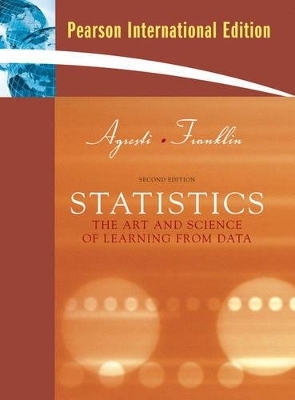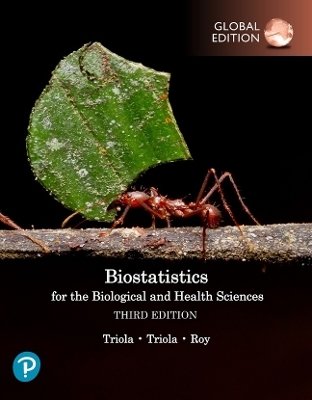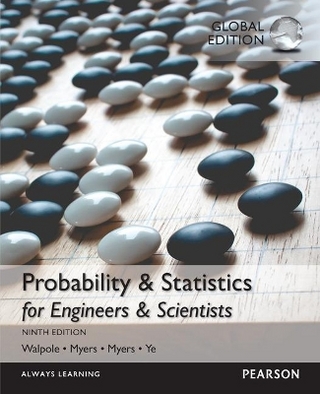
Statistics
Pearson
978-0-13-135746-4 (ISBN)
- Titel erscheint in neuer Auflage
- Artikel merken
The varied and data-rich examples and exercises place heavy emphasis on thinking about and understanding statistical concepts. The applications are topical and current, and successfully illustrate the relevance of statistics. The authors believe that it is important for students to be comfortable with analyzing both quantitative and categorical data. Every day in the media, students see and hear percentages and rates being used to summarize opinion polls, outcomes of medical studies, and economic reports. As a result, greater attention is paid to the analysis of proportions than is typical of many introductory statistic texts.
The text maintains its commitment to the recommendations of the ASA endorsed GAISE (Guidelines for Assessment for Instruction in Statistical Education) Report.
Datasets and other resources (where applicable) for this book are available here.
Alan Agresti is Distinguished Professor in the Department of Statistics at the University of Florida. He has been teaching statistics there for 35 years, including the development of three courses in statistical methods for social science students and three courses in categorical data analysis. He is author of over 100 refereed articles and five texts including "Statistical Methods for the Social Sciences" (with Barbara Finlay, Prentice Hall, 4th edition 2009) and "Categorical Data Analysis" (Wiley, 2nd edition 2002). He is a Fellow of the American Statistical Association and recipient of an Honorary Doctor of Science from De Montfort University in the UK. In 2003 Alan was named "Statistician of the Year" by the Chicago chapter of the American Statistical Association and in 2004 he was the first honoree of the Herman Callaert Leadership Award in Biostatistical Education and Dissemination awarded by the University of Limburgs, Belgium. He has held visiting positions at Harvard University, Boston University, London School of Economics, and Imperial College and has taught courses or short courses for universities and companies in about 30 countries worldwide. Alan has also received teaching awards from UF and an excellence in writing award from John Wiley & Sons. Christine Franklin is a Senior Lecturer and Honors Professor in the Department of Statistics at the University of Georgia. She has been a member of college faculty in statistics for almost 30 years. Chris has been actively involved at the national level with promoting statistical education at the K-12 level and college undergraduate level since the 1980's. She is currently the Chief Reader for AP Statistics and has developed three masters level courses at UGA in data analysis for elementary, middle school, and secondary teachers. Chris was the lead writer for the ASA endorsed Guidelines for Assessment and Instruction in Statistics Education (GAISE) Report: A Pre-K-12 Curriculum Framework. Chris has been honored by her selection as a Fellow of the American Statistical Association, the 2006 Mu Sigma Rho National Statistical Education Award recipient for her teaching and lifetime devotion to statistics education, and numerous teaching and advising awards at UGA. Chris has written more than 30 journal articles and resource materials for textbooks.
PART 1: GATHERING and EXPLORING DATA
1. Statistics: The Art and Science of Learning from Data
1.1 How Can You Investigate Using Data?
1.2 We Learn about Population Using Samples
1.3 What Role do Computers Play in Statistics?
Chapter Summary
Chapter Exercises
2. Exploring Data with Graphs and Numerical Summaries
2.1 What Are the Types of Data?
2.2 How Can We Describe Data using Graphical Summaries?
2.3 How Can We Describe the Center of Quantitative Data?
2.4 How Can We Describe the Spread of Quantitative Data?
2.5 How Can Measures of Position Describe Spread?
2.6 How Can Graphical Summaries Be Misused?
Answers to Chapter Figure Questions
Chapter Summary
Chapter Exercises
3. Association: Contingency, Correlation, and Regression
3.1 How Can We Explore the Association between Two Categorical Variables?
3.2 How Can We Explore the Association between Two Quantitative Variables?
3.3 How Can We Predict the Outcome of a Variable?
3.4 What are Some Cautions in Analyzing Associations?
Answers to Chapter Figure Questions
Chapter Summary
Chapter Exercises
4. Gathering Data
4.1 Should We Experiment or Should We Merely Observe?
4.2 What Are Good Ways and Poor Ways to Sample?
4.3 What Are Good Ways and Poor Ways to Experiment?
4.4 What Are Other Ways to Perform Experimental and Nonexperimental Studies?
Answers to Chapter Figure Questions
Chapter Summary
Chapter Exercises
PART 1 REVIEW
Part 1 Summary
Part 1 Exercises
PART 2: PROBABILITY AND PROBABILITY DISTRIBUTIONS
5. Probability in our Daily Lives
5.1 How Can Probability Quantify Randomness?
5.2 How Can We Find Probabilities?
5.3 Conditional Probability: What’s the Probability of A, Given B?
5.4 Applying the Probability Rules
Answers to Chapter Figure Questions
Chapter Summary
Chapter Exercises
6. Probability Distributions
6.1 How Can We Summarize Possible Outcomes and Their Probabilities?
6.2 How Can We Find Probabilities for Bell-Shaped Distributions?
6.3 How Can We Find Probabilities when Each Observation has Two Possible Outcomes?
Answers to Chapter Figure Questions
Chapter Summary
Chapter Exercises
7. Sampling Distributions
7.1 How Likely Are the Possible Values of a Statistics? The Sampling Distribution
7.2 How Close Are Sample Means to Population Means?
7.3 How Can We Make Inferences about a Population?
Answers to Chapter Figure Questions
Chapter Summary
Chapter Exercises
PART 2 REVIEW
Part 2 Summary
Part 2 Exercises
PART 3: INFERENCE STATISTICS
8. Statistical Inference: Confidence Intervals
8.1 What Are Point and Interval Estimates of Population Parameters?
8.2 How Can We Construct a Confidence Interval to Estimate a Population Proportion?
8.3 How Can We Construct a Confidence Interval to Estimate a Population Mean?
8.4 How Do We Choose the Sample Size for a Study?
8.5 How Do Computers Make New Estimation Methods Possible?
Answers to Chapter Figure Questions
Chapter Summary
Chapter Exercises
9. Statistical Inference: Significance Tests about Hypotheses
9.1 What Are the Steps for Performing a Significance Test?
9.2 Significance Tests about Proportions
9.3 Significance Tests about Means
9.4 Decisions and Types of Errors in Significance Tests
9.5 Limitations of Significance Tests
9.6 How Likely is a Type II Error (Not Rejecting H0, Even though it’s False)?
Answers to Chapter Figure Questions
Chapter Summary
Chapter Exercises
10. Comparing Two Groups
10.1 Categorical Response: How Can We Compare Two Proportions?
10.2 Quantitative Response: How Can We Compare Two Means?
10.3 Other Ways of Comparing Means and Comparing Proportions
10.4 How Can We Analyze Dependent Samples?
10.5 How Can We Adjust for Effects of Other Variables?
Answers to Chapter Figure Questions
Chapter Summary
Chapter Exercises
PART 3 REVIEW
Part 3 Summary
Part 3 Exercises
PART 4: ANALYZING ASSOCIATIONS AND EXTENDED STATISTICAL METHODS
11. Analyzing the Association Between Categorical Variables
11.1 What is Independence and What is Association?
11.2 How Can We Test Whether Categorical Variables are Independent?
11.3 How Strong is the Association?
11.4 How Can Residuals Reveal the Pattern of Association?
11.5 What if the Sample Size is Small? Fisher’s Exact Test
Answers to Chapter Figure Questions
Chapter Summary
Chapter Exercises
12. Analyzing the Association Between Quantitative Variables: Regression Analysis
12.1 How Can We “Model” How Two Variables Are Related?
12.2 How Can We Describe Strength of Association?
12.3 How Can We Make Inferences about the Association?
12.4 What Do We Learn from How the Data Vary around the Regression Line?
12.5 Exponential Regression: A Model for Nonlinearity
Answers to Chapter Figure Questions
Chapter Summary
Chapter Exercises
13. Multiple Regression
13.1 How Can We Use Several Variables to Predict a Response?
13.2 Extending the Correlation and R-squared for Multiple Regression
13.3 How Can We Use Multiple Regression to Make Inferences?
13.4 Checking a Regression Model Using Residual Plots
13.5 How Can Regression Include Categorical Predictors?
13.6 How Can We Model a Categorical Response?
Answers to Chapter Figure Questions
Chapter Summary
Chapter Exercises
14. Comparing Groups: Analysis of Variance Methods
14.1 How Can We Compare Several Means?: One-Way ANOVA
14.2 How Should We Follow Up an ANOVA F Test
14.3 What if there are Two Factors?: Two-way ANOVA
Answers to Chapter Figure Questions
Chapter Summary
Chapter Exercises
15. Nonparametric Statistics
15.1 How Can We Compare Two Groups by Ranking?
15.2 Nonparametric Methods for Several Groups and for Matched Pairs
Answers to Chapter Figure Questions
Chapter Summary
Chapter Exercises
PART 4 REVIEW
Part 4 Summary
Part 4 Exercises
Tables
Selected Answers
Index
Index of Applications
Photo Credits
| Erscheint lt. Verlag | 31.1.2008 |
|---|---|
| Sprache | englisch |
| Maße | 276 x 216 mm |
| Gewicht | 1722 g |
| Themenwelt | Mathematik / Informatik ► Mathematik ► Statistik |
| ISBN-10 | 0-13-135746-8 / 0131357468 |
| ISBN-13 | 978-0-13-135746-4 / 9780131357464 |
| Zustand | Neuware |
| Haben Sie eine Frage zum Produkt? |
aus dem Bereich

